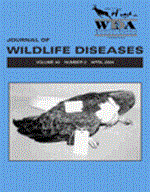Escherichia coli O157:H7 (EC O157) is an important zoonosis. White-tailed deer (Odocoileus virginianus) have been implicated in transmission of this bacterium to humans and have been suggested as reservoirs that might affect carriage in cattle populations. Our study objectives were to estimate prevalence of EC O157 in feces of hunter-harvested deer and to describe fecal shedding patterns in a captive herd sampled over 1 yr. Prevalence of EC O157 in hunter-harvested deer was 0.3% (n=338). In August 2001, EC O157 was detected in one of 55 deer (1.8%) from the captive herd. Prevalence over the 1-yr period was 0.4% (n=226). Escherichia coli O157:H7 was rarely isolated from hunter-harvested deer during the winter. We could not describe a seasonal shedding pattern based on one positive sample in the captive herd. These data do not support a prominent role of deer as a reservoir for EC O157 for cattle or humans.
How to translate text using browser tools
1 April 2004
Prevalence of Escherichia coli O157:H7 in White-tailed Deer from Louisiana
John R. Dunn,
James E. Keen,
David Moreland,
R. Alex Thompson

Journal of Wildlife Diseases
Vol. 40 • No. 2
April 2004
Vol. 40 • No. 2
April 2004
Escherichia coli O157:H7
fecal shedding
foodborne disease
Odocoileus virginianus
prevalence
seasonal
white-tailed deer




